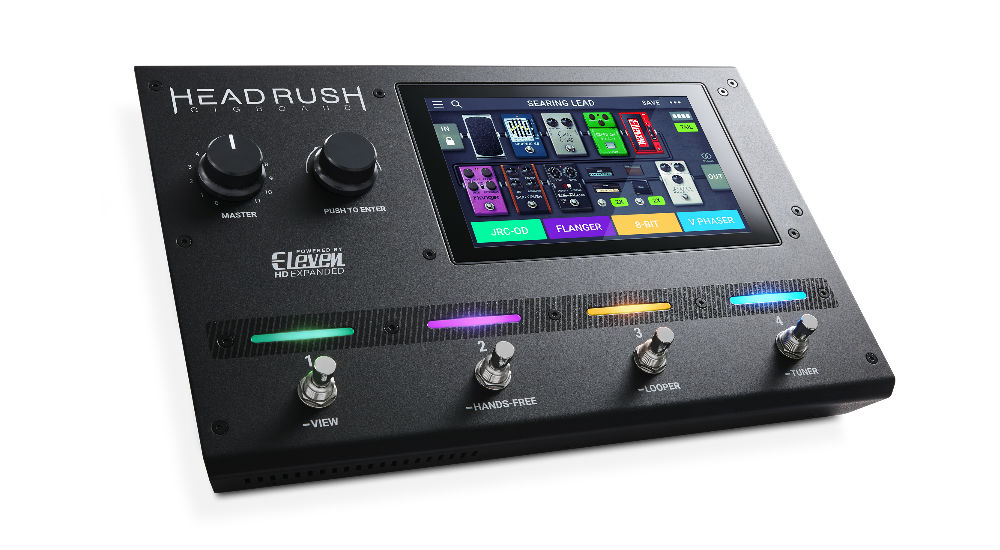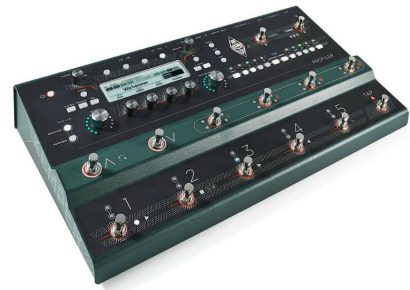The most recent member of the HeadRush multi-effects/amp modelling family is the aptly named Gigboard, which aims to cover all your gigging necessities in a robust, yet compact unit. Don’t let its small size fool you however, as this unit packs a tonne of features into one brilliant package.
The build quality of this unit is exemplary. The Gigboard is housed in an entirely steel frame, with solid metal footswitches and black plastic knobs. The back panel of the Gigboard features inputs for an expression pedal, MIDI connectivity, a 3.5mm auxiliary input, a headphone jack, an effects loop, and an external amp switch – which can be handily assigned to a footswitch to swap channels on your physical amplifier if desired.
At first glance, the most attractive thing about the Gigboard is its sharp seven inch touch screen. The colours are vibrant, text is ultra-clear, and touch sensitivity is crisp and responsive. A combination of a depressible rotary encoder and touch functionality are the primary methods to navigate through the assortment of menus. With some practice, this seemingly unwieldy partnership turned out to be an unlikely winner. I was surprised at how fast I was able to fly through the different menus and modify different sets of parameters, either through dragging on the screen or fine-tuning with the encoder.
Intuitiveness seems to be the recurring theme with the Gigboard. Physical controls are stripped back to the bare minimum – the only activation controls onboard are four colour-coded footswitches and a master volume knob. Thankfully, operating the software itself is a walk in the park. Assigning functions to footswitches, adjusting volume/EQ sliders and replacing/deleting effects in your signal chain is easily performed with mere screen taps.
A surprising amount of both broad and precise control is shared between footswitches one and two. Holding down footswitch one allows you to completely change its activation mode. Options include a classic stomp mode, preset selection, a useful hybrid mode combining the two, or setlist/scene selection. Footswitch two allows further fine-tuning with its hands-free mode, which allows simple parameter modification mid-set. Reaching back to turn your amp’s volume up is a thing of the past.
Let’s get into the meat of the matter – the effects and amps themselves. HeadRush have a comprehensive catalogue of amps, cabs and mics to choose from. In the amplifier section, you’ll find vintage Fender Blackface and Tweed staples, to rockier Marshall-voiced Plexis and high-gain Peavey amps. There’s plenty of variety in the cabinet section too, ranging from a humble 1×8 to a towering 8×10 cab. HeadRush should definitely be commended for their level of detail on their amplifier models. Each virtual amp is faithfully and entirely digitised, all the way down to the EQ settings – older amps that only feature bass and treble controls are similarly resembled onscreen. If you just wanted to get stuck in without creating a chain from scratch, there are plenty of full-rig factory presets to pick from too.
The Gigboard’s effects banks are split into four categories: distortion, dynamics/EQ, modulation, and reverb/delay. Unfortunately, the distortion category is slightly lacking in variety – there are only seven different choices to pick from. Noteworthy classics include a classic 808-voiced Tube Screamer, the timeless Big Muff, and a FullTone OCD (hilariously labelled as the ‘Anxiety Overdrive’). On the other hand, the modulation and reverb/delay section host a much larger collection of effects, and all of these generally sound fantastic. Expect to lose entire days experimenting with the multitude of flangers, phasers, multi-choruses and rotary effects onboard. Creative players can easily stack and combine effects linked to the Gigboard’s stereo outputs; one of the most kaleidoscopic experiences I had with this unit was creating a ping-pong/pitch-shifted delay to two different speaker outputs.
Apart from offering a wealth of amplifiers, cabinets and effects options, the Gigboard also features an extremely well-implemented tuner and looper. The tuner is gloriously large and deadly accurate. Tap tempo for delays and similar effects are also set in the tuning screen, and a handy display even tells you the currently entered BPM. Similarly, the looper is a hidden gem amongst the Gigboard’s features. It’s a single-channel looper featuring a whopping 20 minutes of recording time, with a maximum of 50 layers. The usual controls are available: record, undo and clear, with additional options for doubling or halving loop length or speed. Unfortunately, the undo process is permanent, which means there’s no redo functionality whatsoever – a regrettable oversight which is hopefully patched with any future updates.
At the end of the day, the Gigboard is an all-round excellent and portable alternative that caters to almost every guitarist out there. Its manageable size and versatility allow you to perform anywhere, provided there’s a decent sound system available. If you’ve been wanting to dive into the world of multi-effects without being overwhelmed by option paralysis, the HeadRush Gigboard might just be the solution for you.

